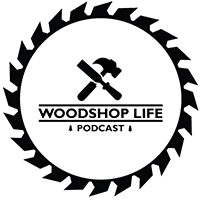This Episodes Questions:
Brians Questions:
I really enjoy your podcast. The information you provide is very informative and helpful. I am beginning to build more furniture items and considering purchasing a Festool Domino tool for both strength and convenience. I am having a difficult time, as I’m sure many do, justifying the cost. My question is: is it that much better and/or stronger than bisquits, dowels, pocket hole screws, fixed tenon, etc., or is this just a “status symbol” tool? Your opinion will help immensely. I do already own their CT Midi dust collector and a couple of sanders. Rick
Gentlemen: I’m a long time listener and can’t thank you enough for all the info you have shared through this podcast. I am a hobbyist woodworker who is moderately successful with my projects the majority of the time. I am being requested to make keepsake/ jewelry boxes for my grandkids. I have not made small boxes before so my questions are:
What species of wood should I consider to use. I have access to some exotics and have used numerous species on previous projects but are there specific species that would really help these boxes standout? Any species I should avoid?
Should I use veneer and plywood or solid hardwood? I am comfortable using miters with splines or finger joints but this guy doesn’t do dovetails.
What finish should I use. I can already hear Guy screaming shellac and amour seal. Anything else to consider like lacquer?
Thanks again Liam Indianapolis
Guys Questions:
Hi gentleman.
Thank you for all of your time sharing your experiences and helping to grow woodworking. You have saved me, and many others, countless board feet of mistakes
I am have transitioned from carpentry and repairs, to fine woodworking, such as desks, and mechanical puzzle boxes. This involves a lot of very precise measurements and cuts. I have needed to cut exact angles to fit together, slide, and hide the seams. You have mentioned using a router bit to cut an exact 45 degree angle, but how do you cut an exact angle other than a 45, such as a 73.43 degree angle?
Also, is there a specific finish that will help minimize wood swelling? While expansion is not always a concern with tables or chairs, for example, it is a real problem with mechanical puzzle boxes as the swelling can prevent the mechanical puzzle box from opening. Thanks for your help. George Allan
Hello Woodshop Life Crew,
I have a 1-car garage woodshop and want to add dust collection. I’m considering the Grizzly G0861 – 2 HP Portable Cyclone Dust Collector. ttps://www.grizzly.com/products/grizzly-2-hp-portable-cyclone-dust-collector/g0861
My shop is 12′ x 24′ and my main tools are a tablesaw, a plainer, and a jointer. Do you think a 2 HP system is too big? Too small? This unit has a 7″ intake port that splits into three 4″ ports, 1023 CFM of airflow, and a 1-micron filter size. A dedicated 30A 220V circuit is at the ready. Given the small shop size, I would be ok with hooking up one tool at a time or adding ducting to all tools. In short, what size of system and ducting would you recommend for a small 1-car woodshop like mine? Thanks as always for the great podcast.- Adam
Huys Questions:
Thanks for the content yall have been bringing the woodworking community. I’m new to the podcast, but have found the few episodes I’ve listened to extremely helpful. I’m living in New Hampshire, and recently moved my shop into a large barn. I have a section for wood storage on the second floor. The barn is open and in an uncontrolled climate. As of right now, I have a lot of pine and white oak, but would like to expand my selection as more projects become available. Do you have any suggestions on how to better control humidity/temperature to allow for better moisture regulation? Also, I am looking to upgrade my planer. I’m trying to decide between a 13 inch Grizzly bench top planer (G0940) and a 13 inch Jet bench top planer (JWP-13BT). Please let me know your thoughts on these or suggestions on another option in that price range. Thanks! Caleb
Hi gentlemen. This is my second question. I’m still catching up on past episodes and am now in 2024. I have learned so much from each of you.
On an earlier episode, you mentioned that if a drawer glue-up is not square, one option is to break it down before the glue sets and “fix it”. My general question is, can you re-glue parts and still maintain their glue strength? If you remove any unset glue (assuming PVA) as much as possible, will the remaining glue embedded in the wood prevent a structurally sound joint? I’m assuming that no further milling is required to “fix” the joint. In other words, the glue-up didn’t go as planned.
Thanks for this great podcast. Anthony
